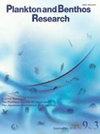在寄居蟹Pagurus nigrofascia中,雄性表现出“反向拍打”,这是对接受雌性的交配行为
IF 0.9
4区 生物学
Q4 MARINE & FRESHWATER BIOLOGY
引用次数: 4
摘要
:本文将“反向拍打”描述为黑龙的一种特征性交配行为。这种行为包括一只寄居蟹将另一只螃蟹的外壳拉向自己,导致外壳相互碰撞。这是第一个证据表明,在帕古龙物种中,雄性会将反向拍打作为一种交配行为。对反振打进行了两次实验,详细描述了反振打过程,并对其作用进行了讨论。在实验A中,我们明确了雄性何时(交配季节或非交配季节)以及对谁(雄性或雌性)表现出这种行为。将一只没有在现场保护的焦点雄性螃蟹与另一只螃蟹放在一起,观察到它们的相互作用,尤其是反向拍打。雄性在交配季节主要与接近交配的雌性表现出反向说唱,尤其是当雄性保护雌性时。在实验B中,我们检查了雌性对雄性反向敲击的反应,并测试了相邻共同体的存在对行为发生的影响。大多数雌性减少了挣扎和/或退回壳中,以回应雄性的反向敲击。相邻螃蟹的存在并没有影响反向敲击。我们的研究结果表明,反向拍打是黑腹蛛的一种交配行为,反向拍打可能有利于雄性开始和/或继续进行种群前保护,因为它有助于约束挣扎的雌性。这种行为在其他同域的帕古龙物种中没有观察到,并且似乎是黑尾龙的一种特征性交配行为。本文章由计算机程序翻译,如有差异,请以英文原文为准。
Males display “inverse rapping” as a mating behavior to receptive females in the hermit crab Pagurus nigrofascia
: This paper describes “ inverse rapping ” as a characteristic mating behavior in Pagurus nigrofascia . The behavior involves one hermit crab pulling another crab ʼ s shell towards itself causing the shells to hit against each other. This is the first evidence that males perform inverse rapping as a mating behavior in a Pagurus species. Two experi-ments were conducted to describe the inverse rapping in detail and to discuss its function. In Experiment A, we clarified when (mating season or non-mating season) and to whom (males or females) males displayed this behavior. A focal male that had not been guarding in the field was placed together with another crab and their interaction was observed, especially inverse rapping. Males showed inverse rapping mainly with a female that was close to copulation in the mating season, especially when the male guarded the female. In Experiment B, we examined the female ʼ s response to male inverse rapping and tested the effect of the presence of a neighboring conspecific on the occurrence of the behavior. Most females reduced struggling and/or withdrew into their shells in response to male inverse rapping. The presence of neighboring crabs did not affect inverse rapping. Our findings suggest that inverse rapping is a mating behavior in P. nigrofascia , and that inverse rapping may benefit males in the initiation and/or continuation of precopulatory guarding because it can help to restrain struggling females. This behavior has not been observed in other sympatric Pagurus species and appears to be a characteristic mating behavior of P. nigrofascia .
求助全文
通过发布文献求助,成功后即可免费获取论文全文。
去求助
来源期刊

Plankton & Benthos Research
Agricultural and Biological Sciences-Aquatic Science
CiteScore
1.30
自引率
0.00%
发文量
32
期刊介绍:
Plankton and Benthos Research is a peer-reviewed journal publishing quarterly original papers, reviews and notes dealing with any aspect of the biology and ecology of planktonic and benthic organisms and their interactions with the environment in any aquatic system, and is open to all scientists around the world. Submission of a paper is held to imply that it represents an original contribution not previously published and that it is not being considered elsewhere.
 求助内容:
求助内容: 应助结果提醒方式:
应助结果提醒方式:


